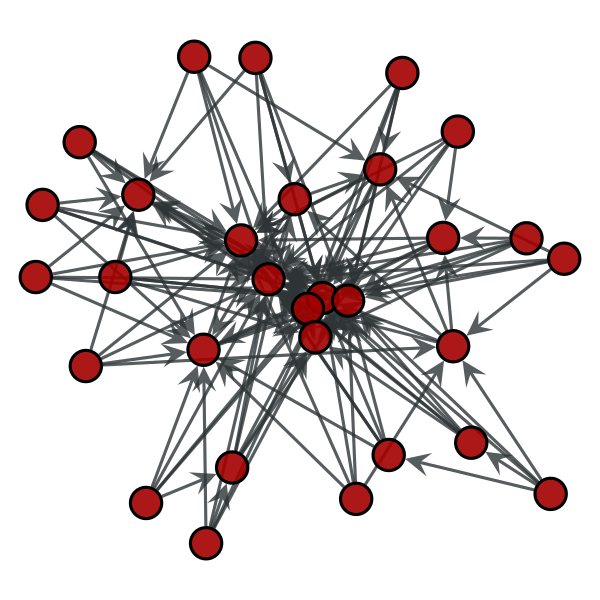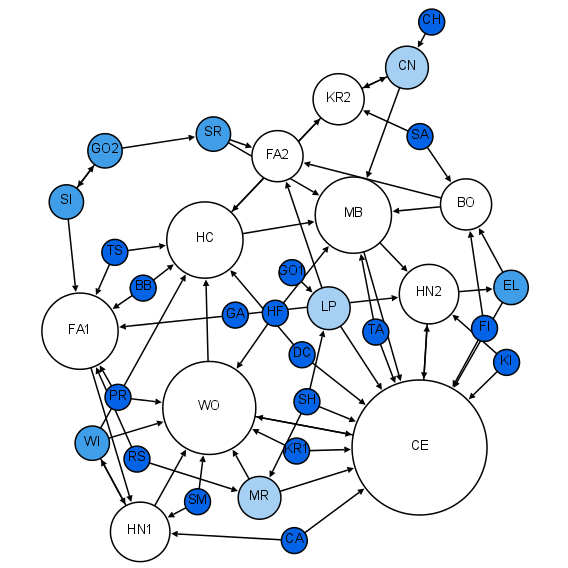|
Link-centric Preferential Attachment
In mathematical modeling of social networks, link-centric preferential attachment is a node's propensity to re-establish links to nodes it has previously been in contact with in time-varying networks. This preferential attachment model relies on nodes keeping memory of previous neighbors up to the current time. Background In real social networks individuals exhibit a tendency to re-connect with past contacts (ex. family, friends, co-workers, etc.) rather than strangers. In 1970, Mark Granovetter examined this behaviour in the social networks of a group of workers and identified tie strength, a characteristic of social ties describing the frequency of contact between two individuals. From this comes the idea of strong and weak ties, where an individual's strong ties are those she has come into frequent contact with. Link-centric preferential attachment aims to explain the mechanism behind strong and weak ties as a stochastic reinforcement process for old ties in agent-based modelin ... [...More Info...] [...Related Items...] OR: [Wikipedia] [Google] [Baidu] |
Time-varying Network
A temporal network, also known as a time-varying network, is a network whose links are active only at certain points in time. Each link carries information on when it is active, along with other possible characteristics such as a weight. Time-varying networks are of particular relevance to spreading processes, like the spread of information and disease, since each link is a contact opportunity and the time ordering of contacts is included. Examples of time-varying networks include communication networks where each link is relatively short or instantaneous, such as phone calls or e-mails.J.-P. Eckmann, E. Moses, and D. Sergi. Entropy of dialogues creates coherent structures in e-mail traffic" ''Proc. Natl. Acad. Sci. USA'' 2004; 101:14333–14337. https://www.weizmann.ac.il/complex/EMoses/pdf/EntropyDialogues.pdf Information spreads over both networks, and some computer viruses spread over the second. Networks of physical proximity, encoding who encounters whom and when, can be re ... [...More Info...] [...Related Items...] OR: [Wikipedia] [Google] [Baidu] |
Preferential Attachment
A preferential attachment process is any of a class of processes in which some quantity, typically some form of wealth or credit, is distributed among a number of individuals or objects according to how much they already have, so that those who are already wealthy receive more than those who are not. "Preferential attachment" is only the most recent of many names that have been given to such processes. They are also referred to under the names Yule process, cumulative advantage, the rich get richer, and the Matthew effect. They are also related to Gibrat's law. The principal reason for scientific interest in preferential attachment is that it can, under suitable circumstances, generate power law distributions. If preferential attachment is non-linear, measured distributions may deviate from a power law. These mechanisms may generate distributions which are approximately power law over transient periods. Definition A preferential attachment process is a stochastic urn process, ... [...More Info...] [...Related Items...] OR: [Wikipedia] [Google] [Baidu] |
Mark Granovetter
Mark Sanford Granovetter (; born October 20, 1943) is an American sociologist and professor at Stanford University. He is best known for his work in social network theory and in economic sociology, particularly his theory on the spread of information in social networks known as ''The Strength of Weak Ties'' (1973). In 2014 Granovetter was named a Citation Laureate by Thomson Reuters and added to that organization’s list of predicted Nobel Prize winners in economics. Data from the Web of Science show that Granovetter has written both the first and third most cited sociology articles. Education Granovetter earned an Bachelor of Arts degree in history at Princeton University (1965) and a PhD in sociology at Harvard University (1970). At Harvard his research was supervised by Harrison White. Career and research Granovetter is currently the Joan Butler Ford Professor in the School of Humanities and Sciences at Stanford and is the chair of the Department of Sociology. He previous ... [...More Info...] [...Related Items...] OR: [Wikipedia] [Google] [Baidu] |
BA Model
BA, Ba, or ba may refer to: Businesses and organizations * Bangladesh Army * Bibliotheca Alexandrina, an Egyptian library and cultural center * Boeing (NYSE stock symbol BA) * Booksellers Association of the UK and Ireland * Boston Acoustics, an audio equipment manufacturer * Boston and Albany Railroad (reporting mark BA) * British Aircraft Manufacturing * British Airways (IATA airline code BA) * British-American Oil, a Canadian petroleum company * British Association for the Advancement of Science * The Nottingham Bluecoat Academy, a Church of England secondary school in Nottingham, England * Selskap med begrenset ansvar, a type of Norwegian company with limited liability * Bundesagentur für Arbeit, Federal Employment Agency of Germany Languages * Bashkir language (ISO 639 alpha-2 language code BA) * Ba (Javanese) (ꦧ), a letter in the Javanese script * Baa language, a Niger-Congo language * Aka-Bo language, an Indian language, also known as ''Ba'' * Arabic letter ب, named ... [...More Info...] [...Related Items...] OR: [Wikipedia] [Google] [Baidu] |
Network Science
Network science is an academic field which studies complex networks such as telecommunication networks, computer networks, biological networks, cognitive and semantic networks, and social networks, considering distinct elements or actors represented by ''nodes'' (or ''vertices'') and the connections between the elements or actors as ''links'' (or ''edges''). The field draws on theories and methods including graph theory from mathematics, statistical mechanics from physics, data mining and information visualization from computer science, inferential modeling from statistics, and social structure from sociology. The United States National Research Council defines network science as "the study of network representations of physical, biological, and social phenomena leading to predictive models of these phenomena." Background and history The study of networks has emerged in diverse disciplines as a means of analyzing complex relational data. The earliest known paper in this f ... [...More Info...] [...Related Items...] OR: [Wikipedia] [Google] [Baidu] |
Interpersonal Tie
In social network analysis and mathematical sociology, interpersonal ties are defined as information-carrying connections between people. Interpersonal ties, generally, come in three varieties: ''strong'', ''weak'' or ''absent''. Weak social ties, it is argued, are responsible for the majority of the embeddedness and structure of social networks in society as well as the transmission of information through these networks. Specifically, more novel information flows to individuals through weak rather than strong ties. Because our close friends tend to move in the same circles that we do, the information they receive overlaps considerably with what we already know. Acquaintances, by contrast, know people that we do not, and thus receive more novel information. Included in the definition of ''absent ties'', according to the American sociologist Mark Granovetter, are those relationships (or ties) without substantial significance, such as "nodding" relationships between people living ... [...More Info...] [...Related Items...] OR: [Wikipedia] [Google] [Baidu] |
Network Theory
Network theory is the study of graphs as a representation of either symmetric relations or asymmetric relations between discrete objects. In computer science and network science, network theory is a part of graph theory: a network can be defined as a graph in which nodes and/or edges have attributes (e.g. names). Network theory has applications in many disciplines including statistical physics, particle physics, computer science, electrical engineering, biology, archaeology, economics, finance, operations research, climatology, ecology, public health, sociology, and neuroscience. Applications of network theory include logistical networks, the World Wide Web, Internet, gene regulatory networks, metabolic networks, social networks, epistemological networks, etc.; see List of network theory topics for more examples. Euler's solution of the Seven Bridges of Königsberg problem is considered to be the first true proof in the theory of networks. Network optimization Network pr ... [...More Info...] [...Related Items...] OR: [Wikipedia] [Google] [Baidu] |


